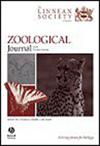Cranial anatomy of the Triassic rhynchosaur Mesosuchus browni based on computed tomography, with a discussion of the vomeronasal system and its deep history in Reptilia
IF 3
2区 生物学
Q1 ZOOLOGY
引用次数: 0
Abstract
The stem lineage of Archosauria is populated by a diverse fossil record that remains notably understudied relative to the crown clade. Prominent among these specimens is a beautifully preserved skull of the early mid-Triassic rhynchosaur Mesosuchus browni [Iziko South African Museum (SAM) 6536], whose phylogenetic position has considerable influence on patterns of pan-archosaurian cranial evolution. We used high-resolution, micro-computed tomography to re-examine the anatomy of this specimen, building on previous studies that were either limited to external observations or restricted to the braincase. A digital segmentation of the cranial elements and primary neurovascular canals of SAM-PK-6536 allows for expanded character scoring and constitutes a foundation for future comparative insights. Our data support the phylogenetically oldest instance of a pneumatized maxilla in a pan-archosaur, bringing the record of antorbital pneumatization into closer alignment with that of the neurocranium. The nasal cavity and primary palate of Mesosuchus includes a complex septomaxilla, a novel element anterior to the vomer, and is likely to have supported a well-developed vomeronasal system. The evolution of this system is discussed in terms of both phylogenetic pattern and how the skeletal architecture of Mesosuchus and other fossils could inform the signalling dynamics that pattern the vomeronasal system during development.基于计算机断层扫描的三叠纪雷暴龙中鼻龙(Mesosuchus browni)颅骨解剖,并讨论爬行动物中的咽喉系统及其深层历史
弓龙类的干系化石种类繁多,但相对于冠龙支系而言,对其的研究仍然明显不足。在这些标本中,最突出的是一个保存完好的早三叠世中期的皱纹龙褐鼻中龙的头骨[Iziko 南非博物馆(SAM)6536],它的系统发育位置对泛弓龙类头骨演化的模式有相当大的影响。我们利用高分辨率的微型计算机断层扫描技术重新研究了该标本的解剖结构,这是在以往仅限于外部观察或仅限于脑壳的研究基础上进行的。通过对 SAM-PK-6536 的颅骨和主要神经血管进行数字分割,可以扩大特征评分范围,为今后的比较研究奠定基础。我们的数据支持了泛始祖龙在系统发育上最古老的上颌骨气化实例,使眶前气化的记录与神经颅的记录更加一致。中棘龙的鼻腔和主腭包括一个复杂的鼻中隔,这是咽鼓膜前方的一个新元素,很可能支持着一个发达的咽鼓管系统。本文从系统发育模式、中鼻龙和其他化石的骨骼结构如何为咽鼓管系统发育过程中的信号动态提供信息等方面讨论了这一系统的进化过程。
本文章由计算机程序翻译,如有差异,请以英文原文为准。
求助全文
约1分钟内获得全文
求助全文
来源期刊
CiteScore
6.50
自引率
10.70%
发文量
116
审稿时长
6-12 weeks
期刊介绍:
The Zoological Journal of the Linnean Society publishes papers on systematic and evolutionary zoology and comparative, functional and other studies where relevant to these areas. Studies of extinct as well as living animals are included. Reviews are also published; these may be invited by the Editorial Board, but uninvited reviews may also be considered. The Zoological Journal also has a wide circulation amongst zoologists and although narrowly specialized papers are not excluded, potential authors should bear that readership in mind.

 求助内容:
求助内容: 应助结果提醒方式:
应助结果提醒方式:


